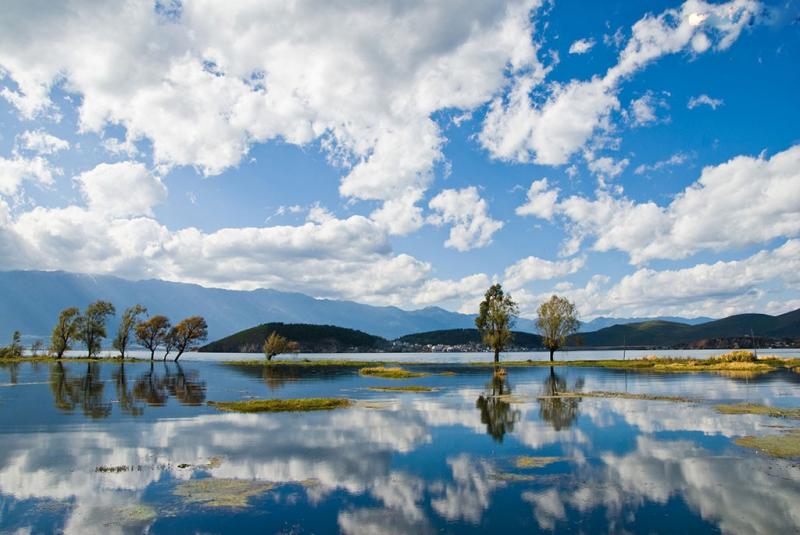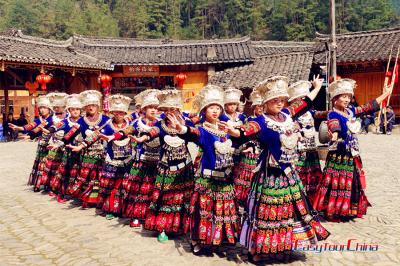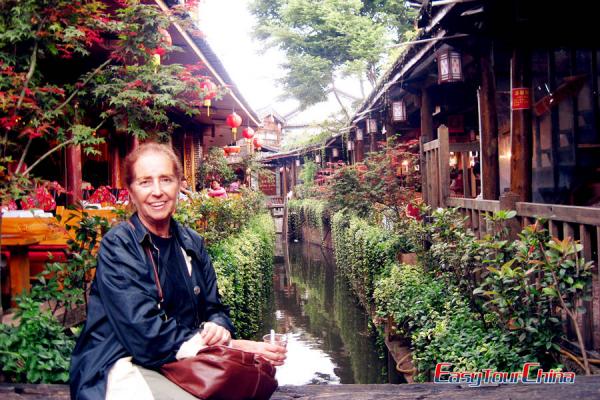Erhai Lake
With an altitude of 1972 meters above sea level, Dali Erhai Lake is a beautiful highland lake of Yunnan, the second largest lake in Yunnan, after Dianchi Lake, and one of the seven largest fresh water lakes in China. As it shapes like an ear, and wave like a sea, the locals named it 'Erhai' - Ear Sea in Chinese language. 2 km east of Dali, the lake encompasses an area of 250 square kilometers, with 40 km long from south to north, 7-9 km wide from east to west. Its circumference reaches 116 km, its average depth is of 11 m and the total storage capacity of 2.5 billion m³.
In 1994, the Cangshan-Erhai National Nature Reserve was established. In 2014, the UNESCO-designated Dali Cangshan Global Geopark was approved, encompassing the geological and landform landscape zone of Erhai Lake and Cangshan Mountain, the cultural landscape zone around Erhai Lake, and the plateau lake landscape zone.
There are three major islands in the lake: Jinsuo, Chiwen and Yuji. Some Buddhist temples and villages are dotted in and around the Erhai Lake, which are worth a visit. The fishing village of Bai Minority provides you a vivid experience of attractive Bai culture and lifestyle. The local farmers still adopt their traditional fishing skill - cormorant fishing. When traveling in Dali, tourists can take a boat cruise in Erhai Lake, or more adventure ones may rent a bike to go around it.

Dali Erhai Lake Facts
How Was Erhai Lake Formed
Erhai Lake lies along the eastern margin of China's most powerful radial tectonic zone—a massive deep-seated fault zone characterized by westward uplift and eastward subsidence known as the Kangzang-Dai-shaped structural fold belt. The Erhai Fault delineates the boundary between the Central Yunnan Plateau and the Hengduan Mountains within this region. During intense uplift, strata fractured and subsided, The uplifted blocks formed the Cangshan mountainous block terrain, while the subsided blocks became a rift basin that filled with water to form Erhai Lake.
Erhai Lake in Dali History: How the Local Residents Live in the Past
In the Neolithic Age, the early inhabitants utilized the terrain between Cangshan and Erhai Lake to build city walls and houses, thus creating the earliest cities. During the Han Dynasty, the plains surrounding Erhai Lake had entered a semi-agricultural and semi-pastoral economic period, characterized by rice paddies and livestock, and tribal confederations had emerged.
During the Tang and Song dynasties, the Nanzhao and Dali Kingdoms successively emerged in Yunnan. The primary settlement belt of residents in the Cangshan-Erhai region connected with the activity areas of their ancestors from the Han and Jin periods at higher elevations, while expanding into a vast lowland plain at lower elevations. The Old Dali Town began to rise and develop.
From the Nanzhao Kingdom to the Ming and Qing Dynasties, the following sites were built around Erhai Lake: Taihe City, Dali City, Longshou City, Longwei City, Yangzuimei City, Sanyang City, Dali Ancient City, Wenxian Tower, the Three Pagodas of Chongsheng Temple, Hongsheng Temple Pagoda, Fotu Temple Pagoda, and Bai ethnic minority residences in Xizhou.
Why It was So Named
Among the Eighteen Wonders of Yunnan, one peculiarity is that “lakes are called seas”—Erhai (literally “Er Sea”) is the most common local name for lakes.

What to Sea on Erhai Lake: Top Attractions
Xiaoputuo Island (Little putuo Island)
Xiaoputuo is a miniature island shaped like a circular seal, hence its alternative name “Sea Seal.” Encircled by over 200 meters of limestone coastline, it lies along the maritime tourist route connecting Xiaguan to Shuanglang and Butterfly Spring. The island's pavilion, originally built during the Ming Dynasty and reconstructed in 1982, features a two-story pavilion-style architecture. The first floor enshrines the Buddha, while the second floor honors Guanyin Bodhisattva.
Legend has it that when Guanyin opened up the Dali Basin, she cast a great seal into the sea here, forming this island to quell storms and protect fishermen. Thus, the fishermen built the Guanyin Pavilion on the island to commemorate her.
Haixin Pavilion
In 1937, Yan Zizhen—the wealthiest merchant of Xizhou Town and founder of the renowned “Yongchangxiang” trading house—constructed a villa blending Chinese and Western styles along the Erhai Lake shore, approximately 3 li northeast of Xizhou Ancient Town. Serving as Yan's retreat for seclusion and leisure, the villa earned the name “Haixin Pavilion” (Pavilion at the Heart of the Sea) due to its water-enclosed location, a name that endures to this day. Haishin Pavilion is not merely a “pavilion” but a private garden spanning over 10,000 square meters, featuring water, pavilions, rocks, bridges, forests, terraces, gazebos, and halls.
Linshui Pavilion
Linshui Pavilion is located east of Dali Ancient City, in front of the Dragon King Temple in Longfeng Village on the western shore of Erhai Lake. The original pavilion dates back to the 17th year of the Jiajing reign of the Ming Dynasty (1538 AD). East of the pavilion, a dragon gate archway stands in the water, inscribed with the characters “Dragon Gate,” “Soaring Kites,” and “Leaping Fish”—reflecting the panoramic views of Erhai Lake's vast waves, soaring birds, and leaping fish visible from within the pavilion.
Chuwen Island
Chuwen Island, one of Erhai Lake's three islands also known as Nanzhao Folk Island, lies west of Shuanglang Ancient Town in the lake's northeast. It measures approximately 1,100 meters east-west and 600 meters north-south.
At the pier square stands a bronze statue of Sha Yimu, flanked by ten column-shaped stone sculptures representing her ten sons. Sha Yi, a fisherwoman from the Ailao Mountains, is said to have conceived after touching driftwood, giving birth to ten sons who became the ancestors of Yunnan's ethnic groups.
At the center of the island's “Yunnan Lucky Star” plaza stands a standing white marble statue of Guanyin. The main structure, the Nanzhao Imperial Villa, once served as the summer retreat for the Duan clan of the Nanzhao Kingdom in Dali, with a total floor area exceeding 8,000 square meters. Its architectural style is based on Tang Dynasty elements, blending Nanzhao and Tibetan influences.
At the western end lies the Benchu Culture Square. Four bronze Benchu statues line each side of the square's perimeter wall, while the center features a forged bronze statue of the “Central Benchu”—Duan Zongbang, revered as the foremost of the Five Hundred Divine Kings and the King of Benchu.
Jinsuo Island
Commonly known as “The Island,” Jinsuo Island lies in the southeastern part of Erhai Lake. Stretching approximately two kilometers north to south with an average width of 370 meters, it rises 250 meters above the water surface, covering an area of about 740,000 square meters. During the Nanzhao period, the island housed the Shari Water City, serving as a summer retreat for the imperial court. As Erhai Lake's largest island, its shape closely resembles a weaving shuttle, earning it the local name “Golden Shuttle Island.”
Yuji Island
Named for the Jade Cliff Hermitage built by Yang Guixian, wife of Duan Siping—founder of the Dali Kingdom—it is commonly called “Juji Island (literally Jade Cliff Island)” by locals. Located west of the ancient fishing village of Shuanglang on Erhai Lake's northeast shore, Yuji Island stretches approximately 700 meters east-west and over 180 meters north-south. Originally a single island, by 1990 a bluestone bridge still connected its eastern tip to the mainland, allowing fishing boats to pass beneath it. Following tourism development after 1992, the island transformed into a peninsula surrounded by water on three sides.
Yu Ji Island features a thousand-year-old banyan tree with lush foliage, while the Bai ethnic fishing village retains its pristine ecological environment. Beyond the Yubo Pavilion and Yu Ji An Hermitage, the island also houses the Zhao Clan Ancestral Hall, the ruins of Du Wenxiu's naval barracks, and the Erhai Lake traditional wooden boat construction yard.

Erhai Lake Ecological Corridor
It serves as an ecological protection and landscape corridor along the Erhai Lake shoreline, connecting 23 traditional Bai ethnic villages. The completed smart monitoring system has helped the vegetation buffer zone reduce inflow velocity by 60%, increase bird species from 94 to 104, and gradually restore native fish populations. According to the Erhai Lake Protection and Management Regulations, motor vehicles and horses are prohibited within the corridor.
>> Recommended Dali tours:
Best Ways to Explore Erhai Lake
Erhai Lake Cruise
There are various ways to enjoy Erhai Lake cruises, departing from different piers. The size of the boats varies, and so do the prices. Below are some of the most popular options. Feel free to consult Easy Tour China's travel experts for more information.
Erhai Lake Grand Cruise Panoramic Tour
Longkan Grand Cruise Panoramic Tour
Longkan Erhai Lake Eco-Tour
Erhai Lake Luxury Yacht Experience Tour
Operating Hours: 9:00 AM – 4:00 PM, 2-hour tour.
Erhai Lake Cycling
Here are we recommend two classic cycling routes around Erhai Lake, which connect the Erhai Lake ecological corridor and the rural landscapes.
The west section around the lake: It is 6 kilometers long and mainly features the rural scenery of the west side of Erhai Lake. Along the way, you can enjoy a distant view of the continuous outlines of the 19 peaks of Cangshan Mountain. During winter cycling, you can encounter groups of migrating seagulls.
The east section around the lake: It is 9 kilometers long and focuses on close-up water-viewing and scenic experiences. The cycling route is less than 1 meter away from the water surface of Erhai Lake, passing through ecological wetlands, viewing platforms and other rest points.
Tourist Bus around Erhai Lake
The sightseeing buses are mainly divided into the East Sea Route and the West Sea Route. The ticket price is around 120 RMB and it can be used unlimited times within 72 hours for three days.
>> Recommended Yunnan tours to Erhai Lake:
Erhai Lake Weather and Best Time to Visit
Erhai Lake has a low-latitude plateau monsoon climate that combines both continental and marine characteristics. It is mainly influenced by factors such as solar radiation, atmospheric circulation, and geographical environment. The climate characteristics of the Erhai Lake area are mild throughout the year, with a small annual temperature variation, large daily temperature difference, sufficient sunlight, and distinct dry and wet seasons.
The annual average temperature is 5.1℃, the highest monthly average temperature is 20.1℃, and the lowest monthly average temperature is 8.8℃. Erhai Lake is suitable for you to visit throughout the year.\
>> Learn more about Dali Weather
How to Get to Erhai Lake
- Take the No. 6 bus or taxi from Xiaguan to reach the Erhai Scenic Area.
- Take the No. 11 bus (large coach) from Dali Ancient City to Longjiang Wharf.
>> Check out Dali Travel Tips
Erhai Lake hotels
Whether you're traveling with children or enjoying your honeymoon in Dali, you can choose your hotel by Erhai Lake from luxury resorts to budget-friendly boutique homestays. We recommend staying in Shuanglang, Wenbi Village (Haidong), Erhai Lake Ecological Corridor (Caicun/Panxi S-Bend), or Dali Ancient Town.
More Attractions in Dali



